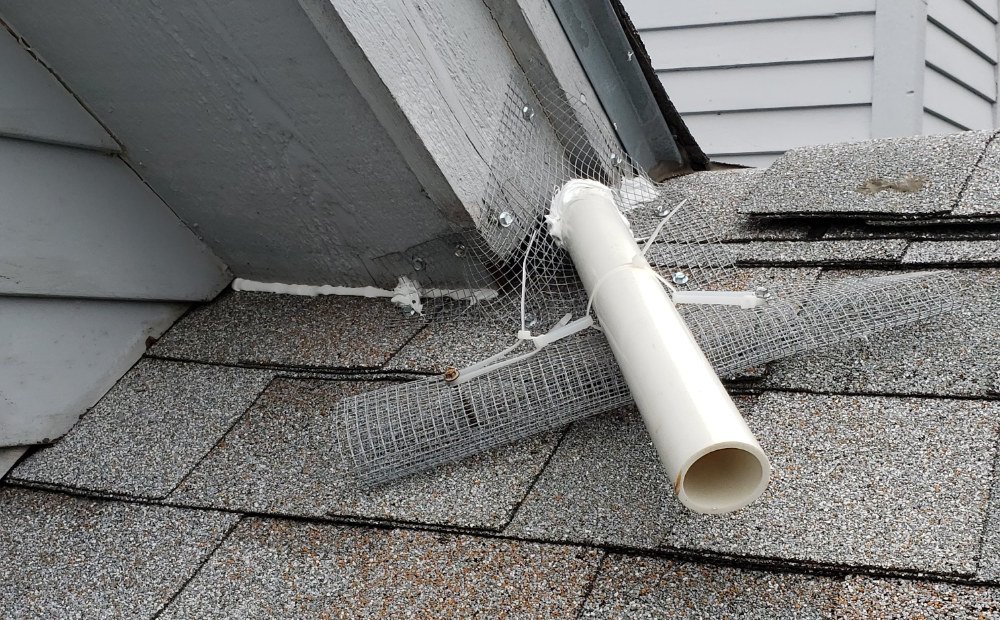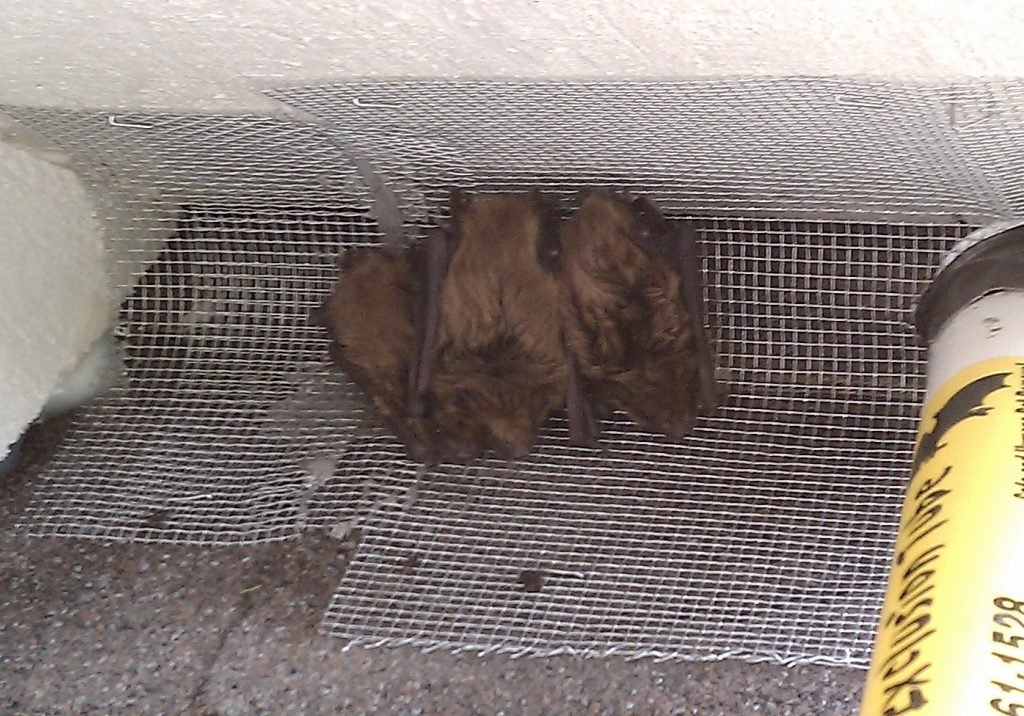How Are Bats Removed From The Attic?

The bat control procedure is far from simple. In a nutshell, wildlife removal experts must figure out how they fly in and out, then place a special one-way device over the exit area (there are several different types for different scenarios) and allow them to fly out but not back in.
If baby bats are around, the bat removal process changes because baby bats often are not old enough to fly through the exclusion devices. Plus, many local and federal regulations make it illegal to removed baby bats from their roost.
Because bats can fit into such small spaces (about 3/8 inch), the process is complicated. The bat control technician needs to be perfect in sealing entry points for the exclusion process to work. 1Go To Source dnr.wisconsin.gov -“BAT FREQUENTLY ASKED QUESTIONS”
The Professional Bat Removal Process
- Bat Inspection: Pre-qualified wildlife technicians will inspect your property for signs that a bat population may be present. Guano build-up and rub marks near entry points in the attic or on the structure’s exterior are both signs of bat activity.
- Bat Entry points Are Sealed: Once the bat control expert has determined that there is indeed a bat problem, he or she will begin locating and sealing potential secondary access points so that bats cannot use them to enter and exit the structure. Most wildlife removal companies use wood trim, elastomeric sealants, and other professional-grade materials to fill gaps and cracks.
- Excluding The Bats: The bats’ main access point can be converted with an excluder once alternative areas of access have been sealed. Exclusion devices act as one-way doors, allowing bats to leave but not return to the attic. The bat excluders are kept in place until all bats have left the infested area.
- Final Entry Point Is Sealed: Bat removal technicians will return after all bats have left the attic to remove the excluders and seal the last access point, ensuring that the problem does not recur.
- Final Walkthrough: After bat removal, an inspection is performed to identify damage and guano-contaminated areas. Wildlife removal technicians will recommend damage needing repair and if the infested area will require a full-blown guano cleanup service.
What Is Bat Exclusion?
Bat exclusion entails using netting or tubes to cover the openings that bats use to enter. The bats can descend and fly out, but they can’t crawl back in.
Keep in mind that bat exclusion is a big job, especially if your house is old and has a lot of cracks where bats can get in. It’s a fairly simple process if your house is structurally sound and only has one or two bat entry points. 2Go To Source dph.illinois.gov -“Bats and Bat Exclusion”
Why Are Bats Not Trapped During The Removal Process?
 Professional bat trapping does not exist, and bat traps, while they do exist, are a terrible method of controlling and removing bat populations. Bats would never be caught by a professional. It simply does not work, and it can be inhumane and often illegal. Many people aren’t satisfied until they see an animal being dragged away in a trap. Please, if you have a bat problem, get rid of that mentality right now.
Professional bat trapping does not exist, and bat traps, while they do exist, are a terrible method of controlling and removing bat populations. Bats would never be caught by a professional. It simply does not work, and it can be inhumane and often illegal. Many people aren’t satisfied until they see an animal being dragged away in a trap. Please, if you have a bat problem, get rid of that mentality right now.
If bats are trapped in a cage or box of any kind, they risk starvation or dehydration or dying of heatstroke and exhaustion if left in the sun. Bats should not be trapped; instead, they should be kept out. That is, they should be evicted from the attic, structure, or building and allowed to leave but not return through exclusion devices. 3Go To Source fs.usda.gov -“Got Bats?”
How Did Get Invade My Attic In The First Place?
Most bat species prefer to live in sheltered, dry, warm environments, so attics are ideal. Because of their nocturnal nature, these winged mammals also prefer dark environments. Attics offer better protection than almost anywhere else, so if a bat can get in, it’ll most likely start roosting there. Then it’s up to you to get them out of there again.
Bats can gain access to attics in a variety of ways. Many species can fit through a gap the size of a dime because they are small and flexible. One of the most common ways for bats to enter a home is through a vent. Warm air is typically blown through vents, which attracts these flying critters. They’re the ideal roosting spot because of this. Some bats will follow the warm air inside the vent and make their way to the attic.
Bats can also enter attics through holes in the roof. Bats can get inside through rotted shingles, gaps in the framing, or the space between the eaves and the walls. A gap can be quite small and still allow bats to pass through.
Can Future Bat Infestations Be Prevented?
 If you’ve just gotten rid of all the bats in the attic or want to protect your home from future infestations, you’ll need a way to keep them out for good. The simplest way to keep bats out is to have a bat control expert examine your home for weak points. Bat proofing includes:
If you’ve just gotten rid of all the bats in the attic or want to protect your home from future infestations, you’ll need a way to keep them out for good. The simplest way to keep bats out is to have a bat control expert examine your home for weak points. Bat proofing includes:
- Full inspection of attic, roofing, siding, vents, and chimneys
- Filling in cracks and gaps in the home’s exterior
- Repairing screens and installing vent/chimney covers to prevent easy access
Because bats can fit through openings as small as a dime, it’s especially important to rely on a bat specialist’s keen eye to spot any potential re-entry points. Using gimmicks such as high-frequency noise products, chemical sprays, and mothballs is ineffective and costly. Instead, rely on a bat professional’s knowledge for advice on long-term bat prevention and maintenance. 4Go To alabamapublichealth.gov -“keep bats out”
Do You Need Bats Removed From The Attic?
Trapping and removing a bat can be difficult and should never be attempted by inexperienced homeowners. The best way to ensure safety is to have your local wildlife control professional handle the procedure. Bat removal experts will identify the entry points bats use to gain access to your home while on the job and make recommendations to keep them out permanently. If you believe bats have infested your attic, call Animals Happen 833-633-1120 to have a wildlife technician inspect your home.
Sources:
- https://dnr.wisconsin.gov/topic/EndangeredResources/batFAQs.html
- https://dph.illinois.gov/topics-services/environmental-health-protection/structural-pest-control/bats-exclusion
- https://www.fs.usda.gov/Internet/FSE_DOCUMENTS/stelprdb5345624.pdf
- https://www.alabamapublichealth.gov/infectiousdiseases/assets/keep_bats_out.pdf
